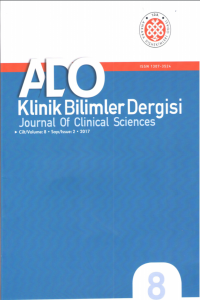Bir Grup Hastada Distomolar Dişlerin ve Sebep Oldukları Patolojilerin Yaygınlığı
Distomolar diş, fazla diş
Prevalence of Distomolar Teeth and Associated Pathoses in a Group of Patients
Distomolar teeth, supernumerary teeth,
___
- Scheiner MA., Sampson WJ. Supernumerary teeth: A review of the literature and four case reports. Aust. Dent. J. 42: 160-165, 1997.
- Buenviaje TM., Rapp R. Dental anomalies in children: A clinical and radiographic survey ASDC J. Dent. Child. 51: 42-46, 1984.
- Mittelman HR., Poliak M. Fourth molars in the maxilla and mandible. Oral Surg. Oral Med. Oral Pathol. 16: 1297-1300, 1963.
- White SC., Pharoah MJ. Oral Radiology: Principles and Interpretation. 4th Ed. St Louis: C.V. Mosby Co., 2000, 303.
- Kakolewska–Maczyńska J., Zyszko A. Paramolar and distomolar teeth. Czas. Stomatol. 43: 232- 237, 1990.
- Gündüz K., Çelenk P. Distomolarlar üzerine retrospektif bir çalışma. Türkiye Klinikleri J. Dental Sci. 12: 83-86, 2006.
- Yusof WZ. Non- syndrome multiple supernumerary teeth: Literature review. J. Can. Dent. Assoc. 56: 147-149, 1990.
- Neville B., Damm D., Allen C., Bouquot J. Oral Maxillofacial Pathology. 2nd Ed. Philadelphia: WB Saunders, 2002, 71.
- Liu DG., Zhang WL., Zhang ZY., Wu YT., Ma XC. Three dimensional evaluations of supernumerary teeth using cone-beam computed tomography for 487 cases. Oral Surg. Oral Med. Oral Pathol. Oral Radiol. Endod. 103: 403-411, 2007.
- Leco Berrocal MI., Martín Morales JF., Martínez González JM. An observational study of the frequency of supernumerary teeth in a population of 2000 patients. Med. Oral Patol. Oral Cir. Bucal. 12: 134-138, 2007.
- Piattelli. A., Tete S. Bilateral maxillary and mandibular fourth molars. Report of a case. Acta Stomatol. Belg. 89: 57-60, 1992.
- Grimanis GA., Kyriakides AT., Spyropoulos ND. A survey on supernumerary molars. Quintessence Int. 22: 989-995, 1991.
- Spauge JD. Oral Pathology. St Louis: Mosby Co. 1973, 223.
- McCrea S. Adjacent dentigerous cysts with the ectopic displacement of a third mandibular molar and supernumerary (forth) molar: a rare occurrence. Oral Surg. Oral Med. Oral Pathol. Oral Radiol. Endod. 107: 15-20, 2009.
- Mupparapu M. Bilateral maxillary and mandibular fourth molars. Br. Dent. J. 193: 363, 2002.
- Mollaoglu N., Güngör K. Süpernümerer dişler: literatür derlemesi ve olgu bildirimleri. Atatürk Üniv. Diş Hek. Fak. Derg. 10: 40-44, 2000.
- Fernández Montenegro P., Valmaseda Castellón E., Berini Aytés L., Gay Escoda C. Retrospective study of 145 supernumerary teeth. Med. Oral Patol. Oral Cir. Bucal. 11: 339-344, 2006.
- Ehsan D., Tu HK., Camarata J. Mandibular supernumerary tooth causing neurosensory changes: A case report. J. Oral Maxillofac. Surg. 58: 1450-1451, 2000.
- Hou GL., Lin CC., Tsai CC. Ectopic supernumerary teeth as a predisposing cause in localized periodontitis. Case report. Aust. Dent. J. 40: 226- 228, 1995.
- Moore JR. Surgery of the mouth and jaws. Oxford: Blackwell scientific publications, 1985, 373.
- Yu Q., Wang P., Shi H., Luo J., Sun D. The lesions of the pterygopalatine and infratemporal spaces: Computed tomography evaluation. Oral Surg. Oral Med. Oral Pathol. Oral Radiol. Endod. 85: 742-751, 1998.
- Clementini M., Ottria L., Pandolfi C., Agrestini C., Barlattani A. Four impacted fourth molars in a young patient: A case report. Oral Implantol. (Rome). 5: 100-103, 2013.
- Shahzad KM., Roth LE. Prevalence and management of fourth molars: A retrospective study and literature review. J. Oral Maxillofac. Surg. 70: 272-275, 2012.
- ISSN: 1307-3540
- Yayın Aralığı: Yılda 3 Sayı
- Başlangıç: 2006
- Yayıncı: Ankara Diş Hekimleri Odası
Beyazlatıcı Bir Diş Pastasının Diş Hassasiyeti Üzerine Etkisi
Periodontal ve Endodontal Yapılar Arasındaki Mikrobiyolojik ve Patolojik Etkileşim
Çift Taraflı Kompaund Odontoma
Nihat DEMİRTAŞ, Şeref EZİRGANLI, Hakkı Oğuz KAZANCIOĞLU, Ahmet MİHMANLI, Suzan BAYER
Bir Grup Hastada Distomolar Dişlerin ve Sebep Oldukları Patolojilerin Yaygınlığı
Utkan Kamil AKYOL, Berrin ÖRS ORUĞ
Geriatrik Hastanın Üst Dudağında İzlenen Mukoepidermoid Karsinoma
Özgür BAŞLARLI, Alper AKTAŞ, Celal TÜMER
Geriatride Protetik Yaklaşımlar
Ayşe Vayısoğlu ÖZCAN, Levent NALBANT, Asude Dilek NALBANT
Restoratif Diş Hekimliğinde Lazer Kullanımı
Diş Çürüklerinin Önlenmesinde Güncel Yaklaşımlar
Dişeti Retraksiyonunda Güncel Yaklaşımlar
Ortodontide İskeletsel Ankraj Yöntemlerinin Risk ve Komplikasyonları
